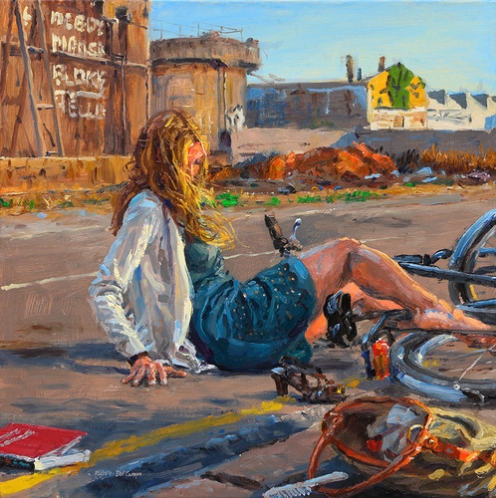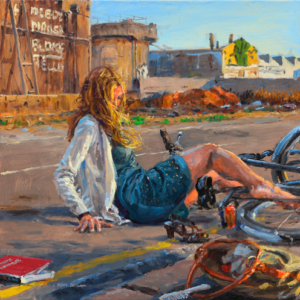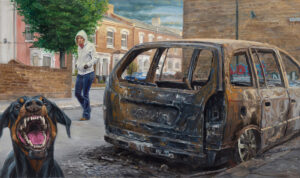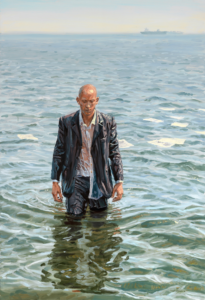
Michele Del Campo interview
interview by George Jackson
Michele Del Campo was born in 1976 in San Nicandro Garganico, a small town in rural South Italy. When he was 18 he moved to Milan where he began his Fine Art studies, before moving to study further in Falmouth, Dundee and Madrid. He moved to London in 2008 where he now lives and works, keeping a studio at the Chocolate Factory. His exhibition at Karamel opens on Thursday 29th June.
How would you introduce someone to your work?
I like to think of my paintings as stories: little stories that suggest moods and situations. They are about young people and their problems and aspirations – snapshots of their life. Not just ordinary moments but moments that have real meaning.
How do you identify moments like that?
I construct them. It’s not something that I see but it is something that I think. I put together various images because I want to say something about these people. I use models to express particular feelings and emotions. For some of the models it is actually their portrait because their life is like that and sometimes my paintings come out of conversations with them. Other times I let models express something that they want to express themselves. Maybe also I want to express something about myself or about something that I have heard. So occasionally they are actors, occasionally they are in their own environment.
What is your process for depicting those moments on the canvas? 
I begin with sketches and when it becomes something that I want to paint I begin to collect images from reality. Normally then I construct the image in photo-shop. I take photos of the subject and the environment as well as other figures. Often the people on the canvas have never met each other in real life but I put everything– objects, cars, characters – together like a collage and it becomes the image that I wanted more or less from the beginning. Sometimes the images are very different from what I had imagined but adapting to this is part of the process.
You were born and raised in the South of Italy. Much of your art seems to depict people from that part of the world, or from a similar background to you. You’ve lived in London since 2008, are you still making art about back home?
I have been influenced by London life a lot but in my painting I often tend to go back to the light I grew up with. When I imagine a scene it is automatic for me to go back to my original environment and imagine the characters as they were in my childhood. They are strong memories! But there is a lot of London in this exhibition also as you can see.
How has working in Wood Green with your studio in the Chocolate factory influenced your work?
Everything has influenced my vision. Actually, there are two main themes in my work – one has more light and colour and the other is darker. The darker one is based in London. It is a difficult city, where I find a lot of elements that inform me about dissatisfaction, longing and melancholy. I tend to use my location in London when I want to paint greyer, more post-industrial settings.
Are these paintings here in the café set in London?
 A few yes, but my influences are various. This one here with the dog shows that: I found the angry dog on Google, the burnt out car was a car that I saw after the riots here in 2011 (I visited the scene in Tottenham and took pictures) and the girl was a model who posed for me for four paintings. She posed on the terrace of my old studio. Everything comes together in the image but it is built up piece by piece. I wanted the spectator to feel like an intruder in that environment. The dog makes you take a step back, and the girl’s expression is wondering what you are doing there.
A few yes, but my influences are various. This one here with the dog shows that: I found the angry dog on Google, the burnt out car was a car that I saw after the riots here in 2011 (I visited the scene in Tottenham and took pictures) and the girl was a model who posed for me for four paintings. She posed on the terrace of my old studio. Everything comes together in the image but it is built up piece by piece. I wanted the spectator to feel like an intruder in that environment. The dog makes you take a step back, and the girl’s expression is wondering what you are doing there.
What do you look for in a model? Beauty, expression, or is that you know them and can be intimate with their emotions in a way?
Sometimes I don’t know them. Sometimes I just see someone and find them interesting. The look is very important. They have to be expressive. If they have the look but not the expression then they are not interesting to me. It’s not good for a painting.
The girl in the canal for example, she posed for me in the nude in a bathtub and I sketched her, and while I was drawing her I observed her expression and it was quite moody. She had that melancholy in her eyes – that rebellious expression. I liked her because of this and told her we should do a painting of you with wet hair in a bath. I thought about her not caring about getting in the canal, and living her life very freely. There is maybe an erotic element but only in the eye of the observer because those figures in the portrait have no interest in her in that way, there is just maybe sadness and loss. All these elements come together: beauty, expression, and the mood also.
The mood conveyed by the characters in your paintings seems to be aloofness, loneliness, rebellion as you say. Why are you attracted to loneliness?
Every painter relates a story that is their story to a certain extent. I think that as a painter I tend to want to show my way of seeing – reality through my eyes. I use models as actors to portray me. Though I rarely do self portraits I think that it is me in these pictures. I find a similarity in the way I feel to someone else who feels the same way and then a connection develops and I find that I want to use these people as models – male or female.
Do you think there is something about young people today, young people in London but also in Mediterranean countries, which makes them especially lonely?
Yes, I think that there is no path to the future for the young. We are bombarded by ideas of what we should do, images of what we should look like. There are lots of contrasting feelings in young people and what I am after is depicting that feeling of not knowing where to go. We come from a big crisis, economically, and my darker paintings began when I started to see my friends who had been ok lose everything and begin to live without security. In the UK less, but in my country and in Spain people have a kind of agony because they do not know what the future holds for them. I have used these people, my friends, for several paintings to very clearly express that feeling.
In the Fall series here at the exhibition is Carles. Carles is a guy that I know very well from Valencia. I painted him falling as a waiter, I painted him in a suit throwing his papers into the sea: just washing himself from the past. I painted him in two other locations, always in this mood and situation of not knowing what he wants to do in this life. He has been to university, he has a Master’s degree, has been through many years of education but he is still doing odd jobs. I want to do something visually to represent this. 
Technically, visually, what are your techniques for expressing loneliness?
It’s all in the face. It’s all in the lack of communication. Often there is very little eye contact and the figures are not talking to one another. I conceive of my paintings as people by themselves in a crowd. They are just thinking. That moment of thinking is for me very timeless, and I want to capture it. This is not a moment when someone is talking energetically and moving their hands. They are suspended in time.
You are running workshops here this weekend. What are the main techniques that you will be trying to give an insight into?
Alla prima is my main technique. I quickly draw a silhouette of all the elements and then I go straight to the paint. It is a quick method of giving shape to things. Pure colours are also important because I like to use as few colours as possible. I have a very big range of colours but instead of mixing too many of them I try to keep the colours as pure as possible, so that each colour comes out individually. The figure, also, I want to teach how to capture a figure in a short amount of time.
The figure is at the core of each of your paintings. In a way each of your paintings is a portrait.
Yes, a portrait of a mood rather than of a particular person. I don’t always think of them of them as portraits because often my models are just actors but the figure is at the heart of what I am trying to express.
Del Campo’s exhibition at Karamel runs until 8 July. There will be a Private View on Thursday 29th June.
